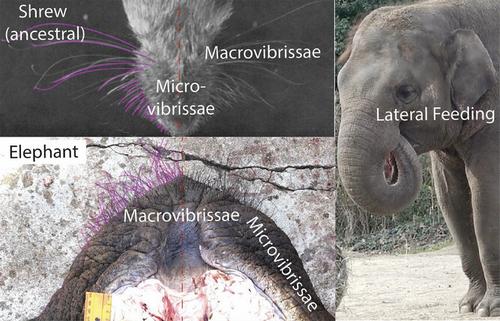当前位置:
X-MOL 学术
›
Ann. N. Y. Acad. Sci.
›
论文详情
Our official English website, www.x-mol.net, welcomes your
feedback! (Note: you will need to create a separate account there.)
Macrovibrissae and microvibrissae inversion and lateralization in elephants
Annals of the New York Academy of Sciences ( IF 4.1 ) Pub Date : 2024-08-05 , DOI: 10.1111/nyas.15194 Hazal Yildiz 1 , Olivia Heise 1 , Ben Gerhardt 1 , Guido Fritsch 2 , Rolf Becker 3 , Andreas Ochs 3 , Florian Sicks 3 , Peter Buss 4 , Lin-Mari de Klerk-Lorist 5 , Thomas Hildebrandt 2 , Michael Brecht 1, 6
Annals of the New York Academy of Sciences ( IF 4.1 ) Pub Date : 2024-08-05 , DOI: 10.1111/nyas.15194 Hazal Yildiz 1 , Olivia Heise 1 , Ben Gerhardt 1 , Guido Fritsch 2 , Rolf Becker 3 , Andreas Ochs 3 , Florian Sicks 3 , Peter Buss 4 , Lin-Mari de Klerk-Lorist 5 , Thomas Hildebrandt 2 , Michael Brecht 1, 6
Affiliation

|
Elephants are known for strongly lateralized trunk behaviors, but the mechanisms driving elephant lateralization are poorly understood. Here, we investigate features of elephant mouth organization that presumably promote lateralization. We find the lower jaw of elephants is of narrow width, but is rostrally strongly elongated even beyond the jaw bone. Elephant lip vibrissae become progressively longer rostrally. Thus, elephants have two lateral dense, short microvibrissae arrays and central, less dense long macrovibrissae. This is an inversion of the ancestral mammalian facial vibrissae pattern, where central, dense short microvibrissae are flanked by two lateral macrovibrissae arrays. Elephant microvibrissae have smaller follicles than macrovibrissae. Similar to trunk-tip vibrissae, elephant lip microvibrissae show laterally asymmetric abrasion. Observations on Asian zoo elephants indicate lateralized abrasion results from lateralized feeding. It appears that the ancestral mammalian mouth (upper and lower lips, incisors, frontal microvibrissae) is shaped by oral food apprehension. The elephant mouth organization radically changed, however, because trunk-mediated feeding replaced oral apprehension. Such elephant mouth changes include the upper lip–nose fusion to the trunk, the super-flexible elongated lower jaw, the loss of incisors, and lateral rather than frontal microvibrissae. Elephants’ specialization for lateral food insertion is reflected by the reduction in the centering effects of oral food apprehension and lip vibrissae patterns.
中文翻译:

大象的大触须和微触须反转和侧化
大象以强烈的躯干侧化行为而闻名,但驱动大象侧化的机制却知之甚少。在这里,我们研究了可能促进侧化的象嘴组织特征。我们发现大象的下颌宽度较窄,但吻部却非常拉长,甚至超出了颌骨。大象的唇触须在喙部逐渐变长。因此,大象有两个侧面密集、短的微触须阵列和中央、不太密集的长大型触须阵列。这是祖先哺乳动物面部触须模式的反转,其中中央密集的短微触须两侧是两个横向大触须阵列。大象微触须的毛囊比大触须更小。与躯干尖端触毛类似,大象唇微触须表现出横向不对称磨损。对亚洲动物园大象的观察表明,侧向进食会导致侧向磨损。看来,哺乳动物祖先的口腔(上唇、下唇、门牙、额叶微触须)是由口腔食物感知形成的。然而,象嘴组织发生了根本性的变化,因为象鼻介导的进食取代了口腔的恐惧。象嘴的这种变化包括上唇鼻与躯干的融合、超灵活的拉长下颌、门牙的丧失以及侧面而不是额部的微触须。大象对侧向食物插入的专门化反映在口腔食物理解和唇触须模式的居中效应的减少。
更新日期:2024-08-05
中文翻译:

大象的大触须和微触须反转和侧化
大象以强烈的躯干侧化行为而闻名,但驱动大象侧化的机制却知之甚少。在这里,我们研究了可能促进侧化的象嘴组织特征。我们发现大象的下颌宽度较窄,但吻部却非常拉长,甚至超出了颌骨。大象的唇触须在喙部逐渐变长。因此,大象有两个侧面密集、短的微触须阵列和中央、不太密集的长大型触须阵列。这是祖先哺乳动物面部触须模式的反转,其中中央密集的短微触须两侧是两个横向大触须阵列。大象微触须的毛囊比大触须更小。与躯干尖端触毛类似,大象唇微触须表现出横向不对称磨损。对亚洲动物园大象的观察表明,侧向进食会导致侧向磨损。看来,哺乳动物祖先的口腔(上唇、下唇、门牙、额叶微触须)是由口腔食物感知形成的。然而,象嘴组织发生了根本性的变化,因为象鼻介导的进食取代了口腔的恐惧。象嘴的这种变化包括上唇鼻与躯干的融合、超灵活的拉长下颌、门牙的丧失以及侧面而不是额部的微触须。大象对侧向食物插入的专门化反映在口腔食物理解和唇触须模式的居中效应的减少。


















































 京公网安备 11010802027423号
京公网安备 11010802027423号